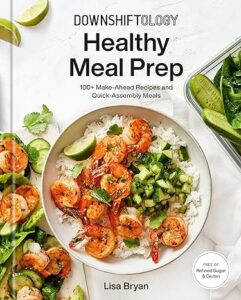Steps to a Healthy Diet
Healthy Eating Habits
Developing healthy eating habits isn’t as confusing or as restrictive as many people imagine. The first principle of a healthy diet is to eat a wide variety of foods, rather than emphasize any one category. This is important because different foods make different nutritional contributions.
 Downshiftology Healthy Meal Prep |
Another basic rule for an optimal diet is that fruits, vegetables, grains, and legumes – the foods high in complex carbohydrates and fiber, low in fat, and free of cholesterol – should make up more than half of the calories you consume; the rest should come from low-fat dairy products, lean meats and poultry, and fish. You should also try to maintain a balance between calorie intake and calorie expenditure. Don’t eat more food than your body can utilize. The more active you are, therefore, the more you can eat and still maintain this balance.
Twelve Recommended Steps to a Healthy Diet
- 1. Keep your total fat intake at or below 30 percent of your total daily calories.
- Limit your intake of fat by choosing lean meats, poultry without the skin, fish, and low-fat dairy products. In addition, cut back on vegetable oils, butter, mayonnaise, salad dressings, and fried foods.
- 2. Limit your intake of saturated fat to less than 10 percent of your fat calories.
- A diet high in saturated fat contributes to high blood cholesterol levels. The richest sources of saturated fat are animal products and tropical vegetable oils, such as coconut or palm oil.
- 3. Keep your cholesterol intake at 300 milligrams per day or less.
- Cholesterol is found only in animal products, such as meats, poultry, dairy products, and egg yolks.
- 4. Eat a diet high in complex carbohydrates.
- Carbohydrates should contribute at least 55 percent of your total daily calories. To help meet this requirement, eat five or more servings of a combination of vegetables and fruits, and six or more servings of whole grains or legumes daily.
- 5. Maintain a moderate protein intake.
- Protein should make up about 12 percent of your total daily calories. Choose low-fat sources of protein.
- 6. Eat a variety of foods.
- Don’t try to fill your nutrient requirements by eating the same foods day in, day out. It is possible that not every essential nutrient is known and eating a wide assortment of foods ensures that you will get all nutrients.
- 7. Avoid too much sugar.
- Besides contributing to tooth decay, sugar is a source of “empty” calories, and many foods that are high in sugar are also high in fat.
- 8. Limit your sodium intake to no more than 2,400 milligrams per day.
- This is equivalent to the amount of sodium in a little more than a teaspoon of salt. Cut back on your use of salt in cooking and on the table; avoid salty foods.
- 9. Maintain an adequate calcium intake.
- Calcium is essential for strong bones and teeth. Get your calcium for low-fat sources, such as skim milk and low-fat yogurt.
- 10. Get your vitamins and minerals from foods, not from supplements.
- Especially avoid supplements that provide more than the Recommended Dietary Allowance (RDA) for any one nutrient.
- 11. Maintain a desirable weight.
- Balance energy (calorie) intake with energy (calorie) output. Eating a low-fat diet will help you maintain – or lower- your weight, as will regular exercise.
- 12. If you drink alcohol, do so in moderation.
- Drink no more than the equivalent of one once of pure alcohol per day. This is the amount in two twelve-ounce beers, two small glasses of wine, or one and a half ounces of spirits.
Following these basic rules doesn’t mean that you have to give up your favorite foods. As long as your overall diet is low in fat and high in complex carbohydrates, there is nothing wrong with an occasional cheeseburger or ice cream cone. Just limit how frequently you eat such foods and eat small portions. You can also view healthy eating as opportunity to expand your repertoire by trying foods – especially vegetables, grains, or fruits – that you don’t normally eat. There’s no reason that eating right has to mean eating foods that are bland or unappealing.
 |
| Healthy Eating Nutrition and Exercise The Right Protein Beyond Hyped Diets Fruits and Vegetables |









I have a hard time not eating meat at every meal. I love beef and pork. I often do not feel satisfied with a meal unless it has some form of animal protein.